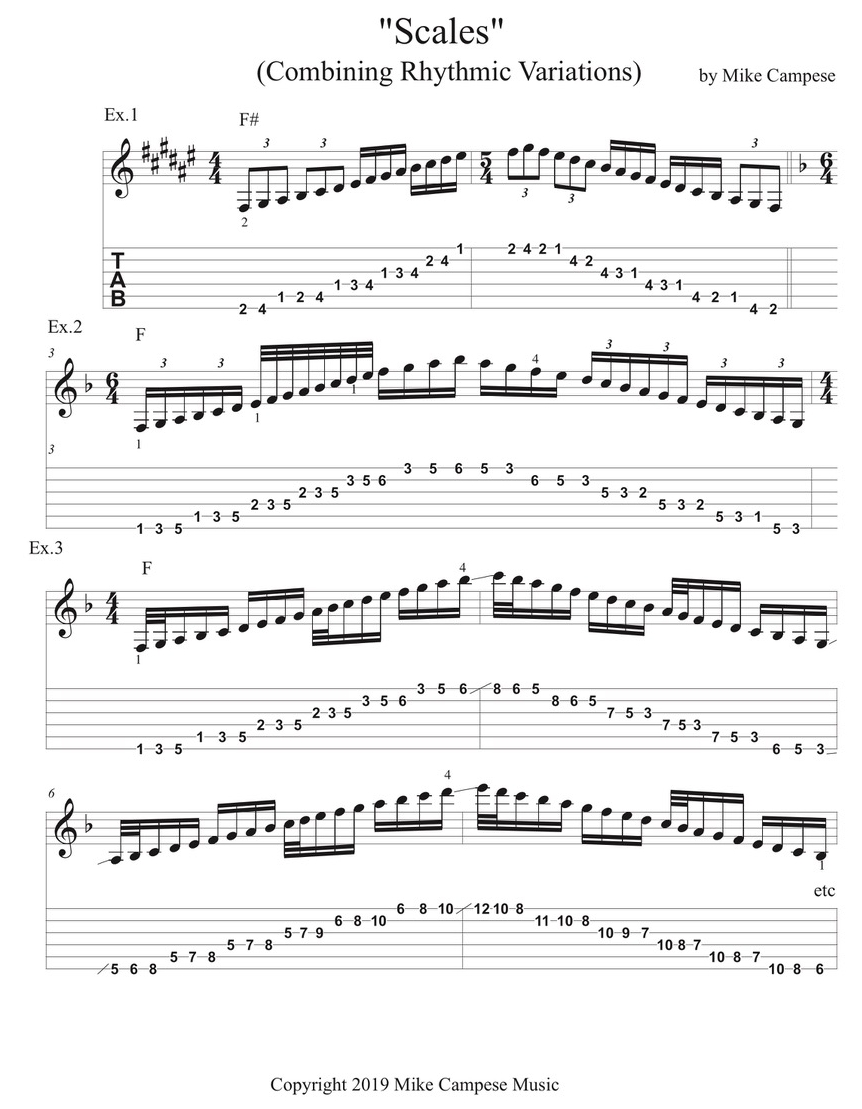Welcome back! In this lesson we will applying and combining rhythmic variations to scales to make them less boring to play, as an alternative just playing the same repeated rhythms.
In the last lesson, we focused on playing the same rhythm in each pattern, using eighth notes, triplets, sixteenths and thirty-second notes. For this lesson, we will be mixing up the rhythms within each pattern to make it much more interesting. This concept works with any scale, so use your imagination. Also, I'm using alternate picking for all these examples.
For the first couple of examples in this lesson, I'm just using one position of the major scale, F# Major (F#, G#, A#, B, C#, D#, E#). Also, F major (F, G, A, Bb, C, D, E). Of course, apply this concept to every possible scale.
In Example 1, we are playing 2 beats of eighth note triplets and 2 beats of 16ths, in the F# major scale. It alternates between both rhythms and you will see this in real life situations. You can make up as many variations as you like. To really get this under your fingers, play this pattern up the neck in half steps. Of course, apply it to all scales.
MP3 - Scales Combining Rhythmic Variations - Example 1 - Slow
MP3 - Scales Combining Rhythmic Variations - Example 1 - Fast
Example 2 is in the key of F Major (F, G, A, Bb, C, D, E), using a common 3-note-per-string pattern. It uses 16th note triplets, 16th and 32nd notes combined. If you are having a hard time with this, count it out. Like the previous example, move this pattern up in half steps. Again, make up different possibilities.
MP3 - Scales Combining Rhythmic Variations - Example 2 - Slow
MP3 - Scales Combining Rhythmic Variations - Example 2 - Fast
Now let's expand this idea in Example 3 to the major scale modes and combine thirty-second notes with sixteenths. The rhythm is, 2 thirty-second notes, followed by 7 sixteenths - and this rhythm continues throughout the 3 note per string patterns. The first pattern ascends and the second one descends - continue this pattern throughout. I only charted out a few patterns, be sure to continue with all seven, all the way up the neck.
MP3 - Scales Combining Rhythmic Variations - Example 3 - Slow
MP3 - Scales Combining Rhythmic Variations - Example 3 - Fast

That is it for now! Be sure to make up your own rhythms with your scales. Also, please don't forget to visit www.mikecampese.com for more details and information, and to purchase CDs and merchandise.
Mike Campese is an all-around music performer, session artist and teacher competent in many musical styles, electric and acoustic. He has studied at G.I.T. (Honors Graduate), and with Paul Gilbert, Norman Brown, Stanley Jordan, Scott Henderson and Keith Wyatt.